NRSG210 Essay: Analyzing Socioeconomic & Psychological Factors of DV
VerifiedAdded on 2023/06/07
|9
|2610
|380
Essay
AI Summary
This essay investigates the socioeconomic and psychological factors contributing to domestic violence in Australia, a significant public health concern. It explores the cycle of violence, highlighting how childhood experiences and psychological factors such as mental health conditions (schizophrenia, bipolar disorder), jealousy, anger, and the concept of masculinity contribute to abusive behaviors. Furthermore, it discusses socioeconomic factors like cultural traditions that subordinate women, unemployment, financial insecurity, workplace stress, and caregiver burnout as key drivers of domestic abuse. The essay concludes by emphasizing the importance of healthcare professionals understanding these factors to develop effective interventions for domestic violence victims and perpetrators, stressing the need to address both psychological and socioeconomic issues to break the cycle of abuse.
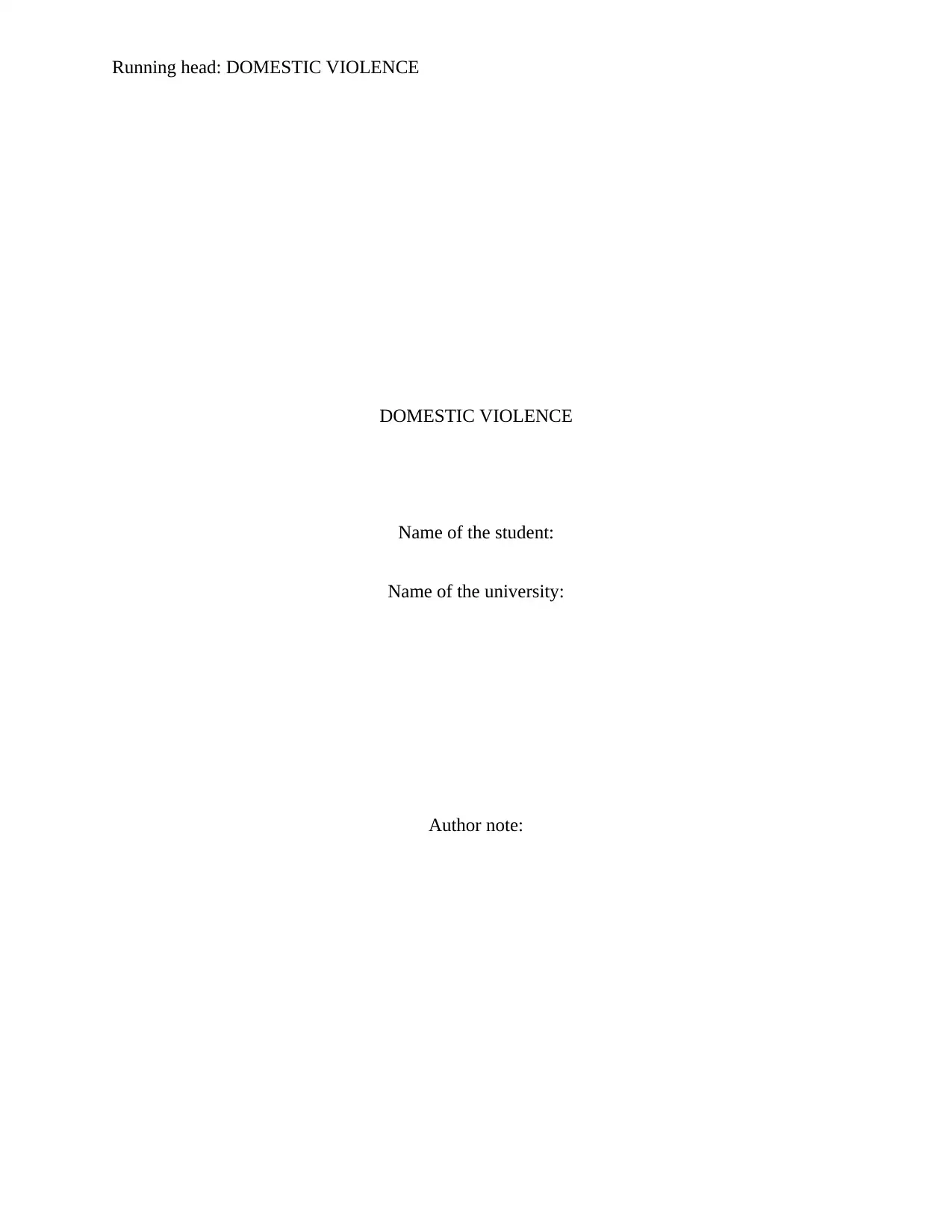
Running head: DOMESTIC VIOLENCE
DOMESTIC VIOLENCE
Name of the student:
Name of the university:
Author note:
DOMESTIC VIOLENCE
Name of the student:
Name of the university:
Author note:
Paraphrase This Document
Need a fresh take? Get an instant paraphrase of this document with our AI Paraphraser
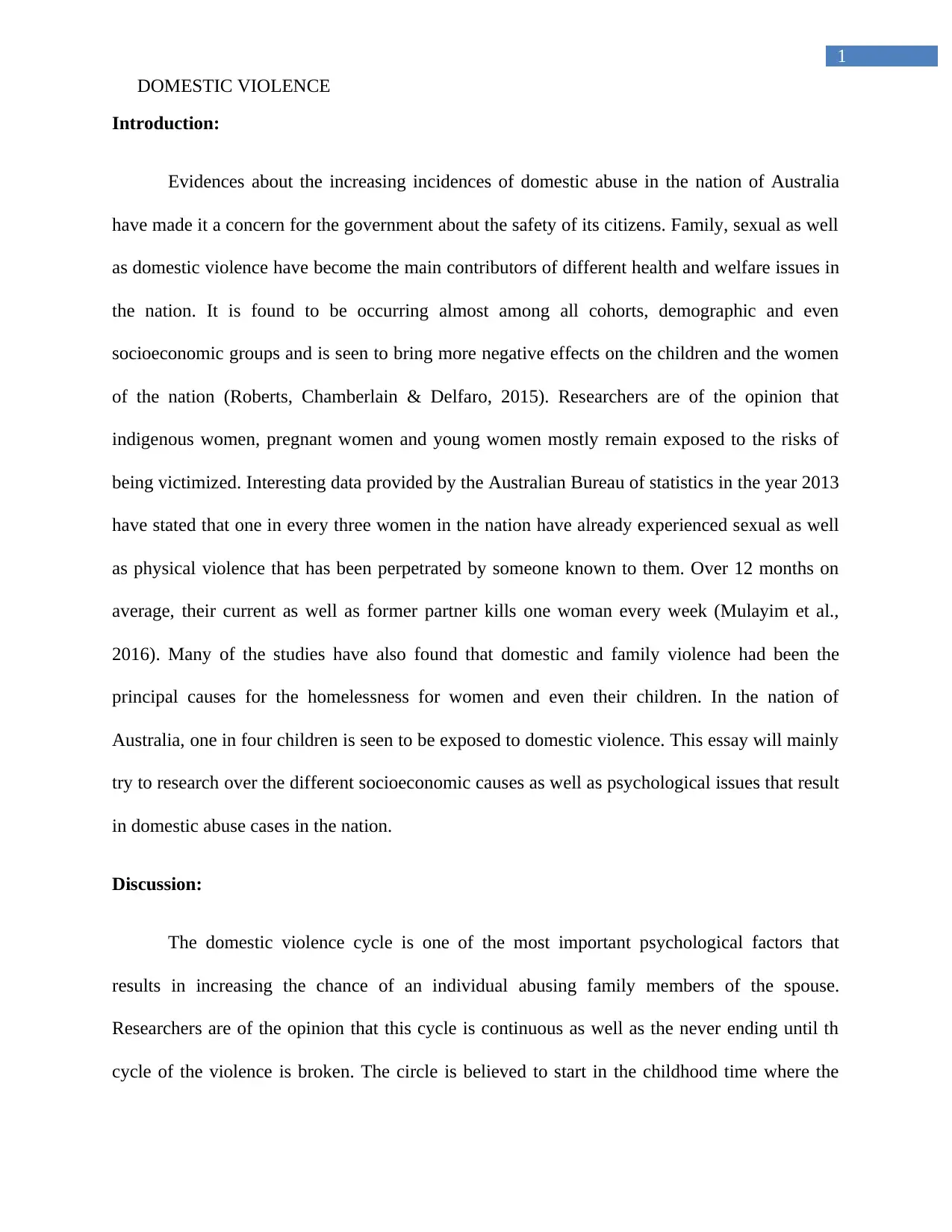
1
DOMESTIC VIOLENCE
Introduction:
Evidences about the increasing incidences of domestic abuse in the nation of Australia
have made it a concern for the government about the safety of its citizens. Family, sexual as well
as domestic violence have become the main contributors of different health and welfare issues in
the nation. It is found to be occurring almost among all cohorts, demographic and even
socioeconomic groups and is seen to bring more negative effects on the children and the women
of the nation (Roberts, Chamberlain & Delfaro, 2015). Researchers are of the opinion that
indigenous women, pregnant women and young women mostly remain exposed to the risks of
being victimized. Interesting data provided by the Australian Bureau of statistics in the year 2013
have stated that one in every three women in the nation have already experienced sexual as well
as physical violence that has been perpetrated by someone known to them. Over 12 months on
average, their current as well as former partner kills one woman every week (Mulayim et al.,
2016). Many of the studies have also found that domestic and family violence had been the
principal causes for the homelessness for women and even their children. In the nation of
Australia, one in four children is seen to be exposed to domestic violence. This essay will mainly
try to research over the different socioeconomic causes as well as psychological issues that result
in domestic abuse cases in the nation.
Discussion:
The domestic violence cycle is one of the most important psychological factors that
results in increasing the chance of an individual abusing family members of the spouse.
Researchers are of the opinion that this cycle is continuous as well as the never ending until th
cycle of the violence is broken. The circle is believed to start in the childhood time where the
DOMESTIC VIOLENCE
Introduction:
Evidences about the increasing incidences of domestic abuse in the nation of Australia
have made it a concern for the government about the safety of its citizens. Family, sexual as well
as domestic violence have become the main contributors of different health and welfare issues in
the nation. It is found to be occurring almost among all cohorts, demographic and even
socioeconomic groups and is seen to bring more negative effects on the children and the women
of the nation (Roberts, Chamberlain & Delfaro, 2015). Researchers are of the opinion that
indigenous women, pregnant women and young women mostly remain exposed to the risks of
being victimized. Interesting data provided by the Australian Bureau of statistics in the year 2013
have stated that one in every three women in the nation have already experienced sexual as well
as physical violence that has been perpetrated by someone known to them. Over 12 months on
average, their current as well as former partner kills one woman every week (Mulayim et al.,
2016). Many of the studies have also found that domestic and family violence had been the
principal causes for the homelessness for women and even their children. In the nation of
Australia, one in four children is seen to be exposed to domestic violence. This essay will mainly
try to research over the different socioeconomic causes as well as psychological issues that result
in domestic abuse cases in the nation.
Discussion:
The domestic violence cycle is one of the most important psychological factors that
results in increasing the chance of an individual abusing family members of the spouse.
Researchers are of the opinion that this cycle is continuous as well as the never ending until th
cycle of the violence is broken. The circle is believed to start in the childhood time where the
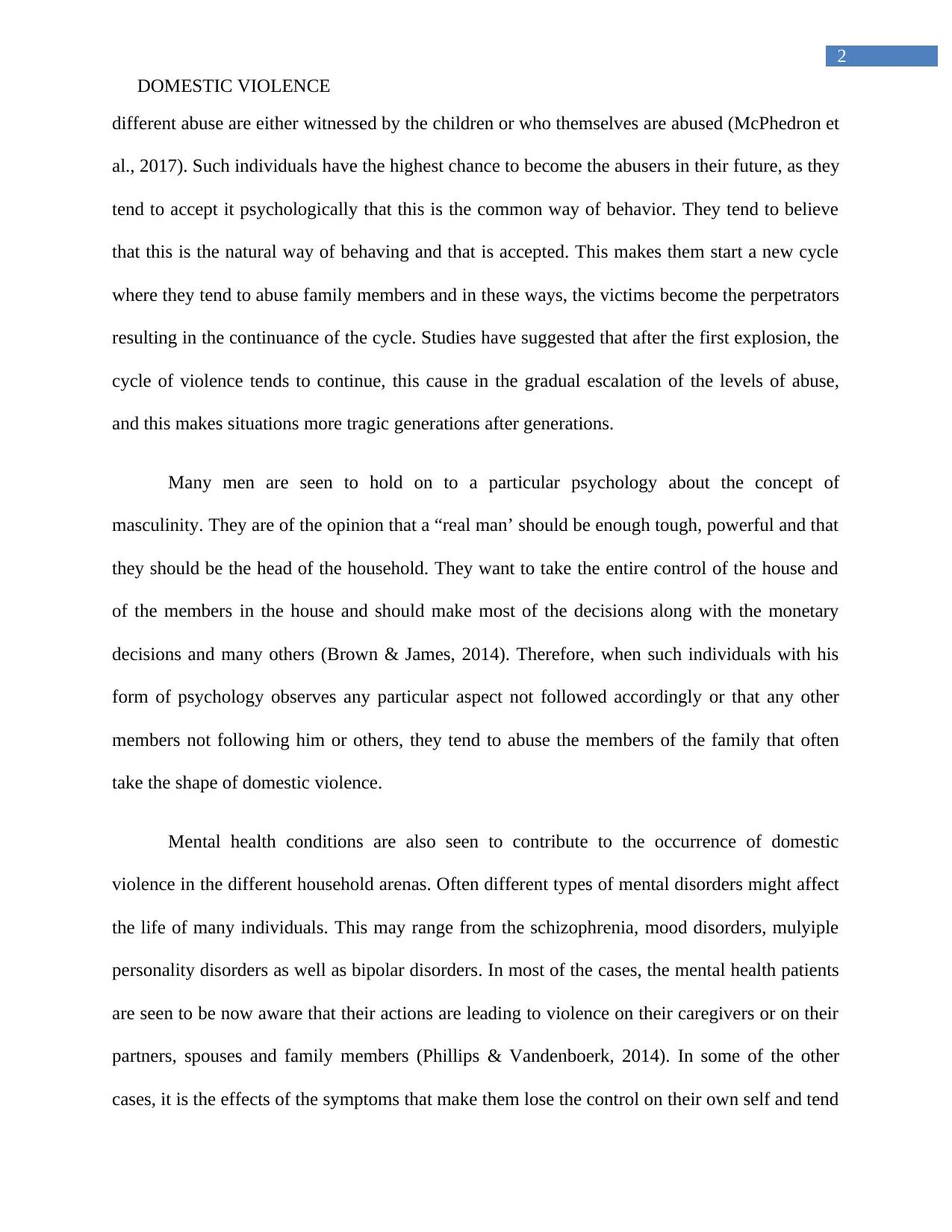
2
DOMESTIC VIOLENCE
different abuse are either witnessed by the children or who themselves are abused (McPhedron et
al., 2017). Such individuals have the highest chance to become the abusers in their future, as they
tend to accept it psychologically that this is the common way of behavior. They tend to believe
that this is the natural way of behaving and that is accepted. This makes them start a new cycle
where they tend to abuse family members and in these ways, the victims become the perpetrators
resulting in the continuance of the cycle. Studies have suggested that after the first explosion, the
cycle of violence tends to continue, this cause in the gradual escalation of the levels of abuse,
and this makes situations more tragic generations after generations.
Many men are seen to hold on to a particular psychology about the concept of
masculinity. They are of the opinion that a “real man’ should be enough tough, powerful and that
they should be the head of the household. They want to take the entire control of the house and
of the members in the house and should make most of the decisions along with the monetary
decisions and many others (Brown & James, 2014). Therefore, when such individuals with his
form of psychology observes any particular aspect not followed accordingly or that any other
members not following him or others, they tend to abuse the members of the family that often
take the shape of domestic violence.
Mental health conditions are also seen to contribute to the occurrence of domestic
violence in the different household arenas. Often different types of mental disorders might affect
the life of many individuals. This may range from the schizophrenia, mood disorders, mulyiple
personality disorders as well as bipolar disorders. In most of the cases, the mental health patients
are seen to be now aware that their actions are leading to violence on their caregivers or on their
partners, spouses and family members (Phillips & Vandenboerk, 2014). In some of the other
cases, it is the effects of the symptoms that make them lose the control on their own self and tend
DOMESTIC VIOLENCE
different abuse are either witnessed by the children or who themselves are abused (McPhedron et
al., 2017). Such individuals have the highest chance to become the abusers in their future, as they
tend to accept it psychologically that this is the common way of behavior. They tend to believe
that this is the natural way of behaving and that is accepted. This makes them start a new cycle
where they tend to abuse family members and in these ways, the victims become the perpetrators
resulting in the continuance of the cycle. Studies have suggested that after the first explosion, the
cycle of violence tends to continue, this cause in the gradual escalation of the levels of abuse,
and this makes situations more tragic generations after generations.
Many men are seen to hold on to a particular psychology about the concept of
masculinity. They are of the opinion that a “real man’ should be enough tough, powerful and that
they should be the head of the household. They want to take the entire control of the house and
of the members in the house and should make most of the decisions along with the monetary
decisions and many others (Brown & James, 2014). Therefore, when such individuals with his
form of psychology observes any particular aspect not followed accordingly or that any other
members not following him or others, they tend to abuse the members of the family that often
take the shape of domestic violence.
Mental health conditions are also seen to contribute to the occurrence of domestic
violence in the different household arenas. Often different types of mental disorders might affect
the life of many individuals. This may range from the schizophrenia, mood disorders, mulyiple
personality disorders as well as bipolar disorders. In most of the cases, the mental health patients
are seen to be now aware that their actions are leading to violence on their caregivers or on their
partners, spouses and family members (Phillips & Vandenboerk, 2014). In some of the other
cases, it is the effects of the symptoms that make them lose the control on their own self and tend
⊘ This is a preview!⊘
Do you want full access?
Subscribe today to unlock all pages.

Trusted by 1+ million students worldwide
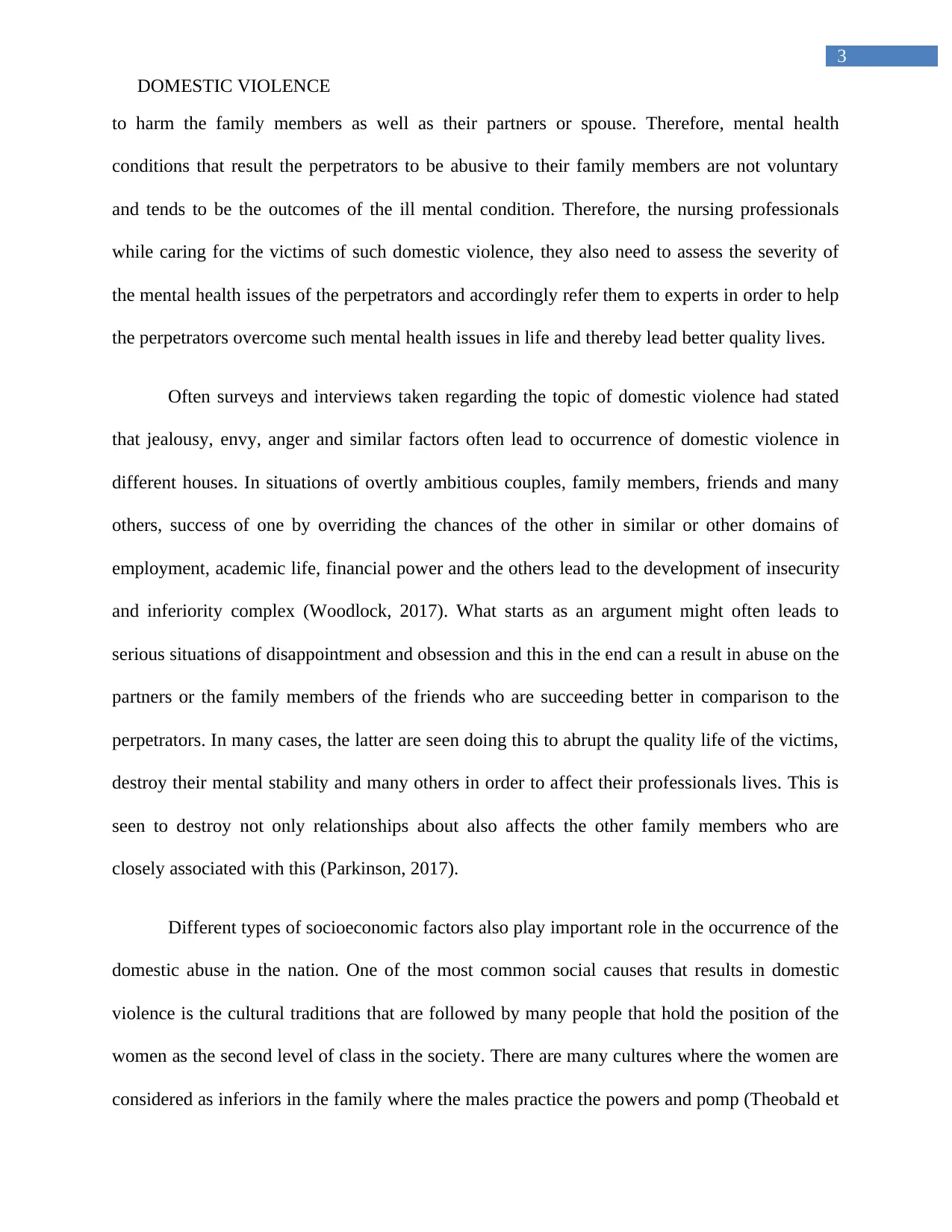
3
DOMESTIC VIOLENCE
to harm the family members as well as their partners or spouse. Therefore, mental health
conditions that result the perpetrators to be abusive to their family members are not voluntary
and tends to be the outcomes of the ill mental condition. Therefore, the nursing professionals
while caring for the victims of such domestic violence, they also need to assess the severity of
the mental health issues of the perpetrators and accordingly refer them to experts in order to help
the perpetrators overcome such mental health issues in life and thereby lead better quality lives.
Often surveys and interviews taken regarding the topic of domestic violence had stated
that jealousy, envy, anger and similar factors often lead to occurrence of domestic violence in
different houses. In situations of overtly ambitious couples, family members, friends and many
others, success of one by overriding the chances of the other in similar or other domains of
employment, academic life, financial power and the others lead to the development of insecurity
and inferiority complex (Woodlock, 2017). What starts as an argument might often leads to
serious situations of disappointment and obsession and this in the end can a result in abuse on the
partners or the family members of the friends who are succeeding better in comparison to the
perpetrators. In many cases, the latter are seen doing this to abrupt the quality life of the victims,
destroy their mental stability and many others in order to affect their professionals lives. This is
seen to destroy not only relationships about also affects the other family members who are
closely associated with this (Parkinson, 2017).
Different types of socioeconomic factors also play important role in the occurrence of the
domestic abuse in the nation. One of the most common social causes that results in domestic
violence is the cultural traditions that are followed by many people that hold the position of the
women as the second level of class in the society. There are many cultures where the women are
considered as inferiors in the family where the males practice the powers and pomp (Theobald et
DOMESTIC VIOLENCE
to harm the family members as well as their partners or spouse. Therefore, mental health
conditions that result the perpetrators to be abusive to their family members are not voluntary
and tends to be the outcomes of the ill mental condition. Therefore, the nursing professionals
while caring for the victims of such domestic violence, they also need to assess the severity of
the mental health issues of the perpetrators and accordingly refer them to experts in order to help
the perpetrators overcome such mental health issues in life and thereby lead better quality lives.
Often surveys and interviews taken regarding the topic of domestic violence had stated
that jealousy, envy, anger and similar factors often lead to occurrence of domestic violence in
different houses. In situations of overtly ambitious couples, family members, friends and many
others, success of one by overriding the chances of the other in similar or other domains of
employment, academic life, financial power and the others lead to the development of insecurity
and inferiority complex (Woodlock, 2017). What starts as an argument might often leads to
serious situations of disappointment and obsession and this in the end can a result in abuse on the
partners or the family members of the friends who are succeeding better in comparison to the
perpetrators. In many cases, the latter are seen doing this to abrupt the quality life of the victims,
destroy their mental stability and many others in order to affect their professionals lives. This is
seen to destroy not only relationships about also affects the other family members who are
closely associated with this (Parkinson, 2017).
Different types of socioeconomic factors also play important role in the occurrence of the
domestic abuse in the nation. One of the most common social causes that results in domestic
violence is the cultural traditions that are followed by many people that hold the position of the
women as the second level of class in the society. There are many cultures where the women are
considered as inferiors in the family where the males practice the powers and pomp (Theobald et
Paraphrase This Document
Need a fresh take? Get an instant paraphrase of this document with our AI Paraphraser
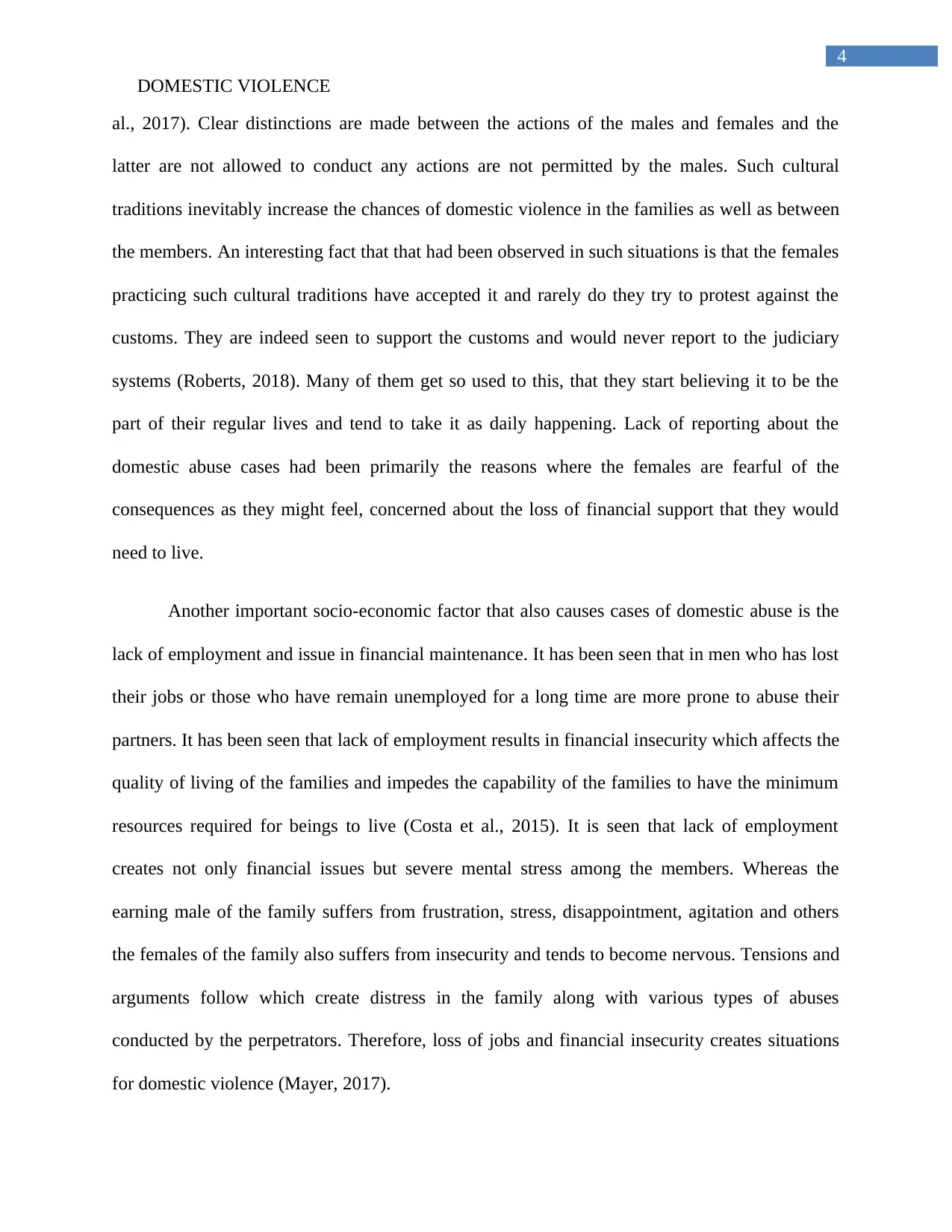
4
DOMESTIC VIOLENCE
al., 2017). Clear distinctions are made between the actions of the males and females and the
latter are not allowed to conduct any actions are not permitted by the males. Such cultural
traditions inevitably increase the chances of domestic violence in the families as well as between
the members. An interesting fact that that had been observed in such situations is that the females
practicing such cultural traditions have accepted it and rarely do they try to protest against the
customs. They are indeed seen to support the customs and would never report to the judiciary
systems (Roberts, 2018). Many of them get so used to this, that they start believing it to be the
part of their regular lives and tend to take it as daily happening. Lack of reporting about the
domestic abuse cases had been primarily the reasons where the females are fearful of the
consequences as they might feel, concerned about the loss of financial support that they would
need to live.
Another important socio-economic factor that also causes cases of domestic abuse is the
lack of employment and issue in financial maintenance. It has been seen that in men who has lost
their jobs or those who have remain unemployed for a long time are more prone to abuse their
partners. It has been seen that lack of employment results in financial insecurity which affects the
quality of living of the families and impedes the capability of the families to have the minimum
resources required for beings to live (Costa et al., 2015). It is seen that lack of employment
creates not only financial issues but severe mental stress among the members. Whereas the
earning male of the family suffers from frustration, stress, disappointment, agitation and others
the females of the family also suffers from insecurity and tends to become nervous. Tensions and
arguments follow which create distress in the family along with various types of abuses
conducted by the perpetrators. Therefore, loss of jobs and financial insecurity creates situations
for domestic violence (Mayer, 2017).
DOMESTIC VIOLENCE
al., 2017). Clear distinctions are made between the actions of the males and females and the
latter are not allowed to conduct any actions are not permitted by the males. Such cultural
traditions inevitably increase the chances of domestic violence in the families as well as between
the members. An interesting fact that that had been observed in such situations is that the females
practicing such cultural traditions have accepted it and rarely do they try to protest against the
customs. They are indeed seen to support the customs and would never report to the judiciary
systems (Roberts, 2018). Many of them get so used to this, that they start believing it to be the
part of their regular lives and tend to take it as daily happening. Lack of reporting about the
domestic abuse cases had been primarily the reasons where the females are fearful of the
consequences as they might feel, concerned about the loss of financial support that they would
need to live.
Another important socio-economic factor that also causes cases of domestic abuse is the
lack of employment and issue in financial maintenance. It has been seen that in men who has lost
their jobs or those who have remain unemployed for a long time are more prone to abuse their
partners. It has been seen that lack of employment results in financial insecurity which affects the
quality of living of the families and impedes the capability of the families to have the minimum
resources required for beings to live (Costa et al., 2015). It is seen that lack of employment
creates not only financial issues but severe mental stress among the members. Whereas the
earning male of the family suffers from frustration, stress, disappointment, agitation and others
the females of the family also suffers from insecurity and tends to become nervous. Tensions and
arguments follow which create distress in the family along with various types of abuses
conducted by the perpetrators. Therefore, loss of jobs and financial insecurity creates situations
for domestic violence (Mayer, 2017).
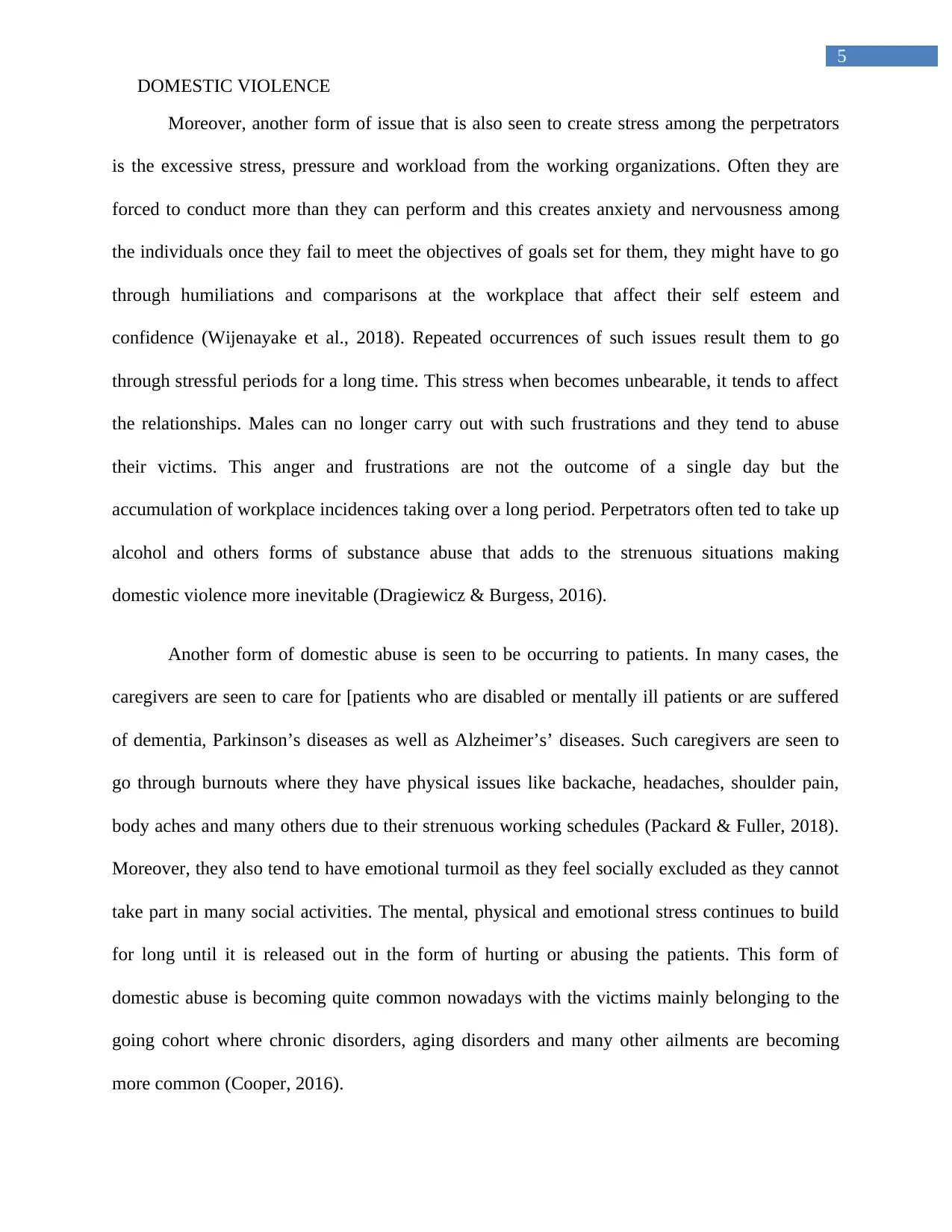
5
DOMESTIC VIOLENCE
Moreover, another form of issue that is also seen to create stress among the perpetrators
is the excessive stress, pressure and workload from the working organizations. Often they are
forced to conduct more than they can perform and this creates anxiety and nervousness among
the individuals once they fail to meet the objectives of goals set for them, they might have to go
through humiliations and comparisons at the workplace that affect their self esteem and
confidence (Wijenayake et al., 2018). Repeated occurrences of such issues result them to go
through stressful periods for a long time. This stress when becomes unbearable, it tends to affect
the relationships. Males can no longer carry out with such frustrations and they tend to abuse
their victims. This anger and frustrations are not the outcome of a single day but the
accumulation of workplace incidences taking over a long period. Perpetrators often ted to take up
alcohol and others forms of substance abuse that adds to the strenuous situations making
domestic violence more inevitable (Dragiewicz & Burgess, 2016).
Another form of domestic abuse is seen to be occurring to patients. In many cases, the
caregivers are seen to care for [patients who are disabled or mentally ill patients or are suffered
of dementia, Parkinson’s diseases as well as Alzheimer’s’ diseases. Such caregivers are seen to
go through burnouts where they have physical issues like backache, headaches, shoulder pain,
body aches and many others due to their strenuous working schedules (Packard & Fuller, 2018).
Moreover, they also tend to have emotional turmoil as they feel socially excluded as they cannot
take part in many social activities. The mental, physical and emotional stress continues to build
for long until it is released out in the form of hurting or abusing the patients. This form of
domestic abuse is becoming quite common nowadays with the victims mainly belonging to the
going cohort where chronic disorders, aging disorders and many other ailments are becoming
more common (Cooper, 2016).
DOMESTIC VIOLENCE
Moreover, another form of issue that is also seen to create stress among the perpetrators
is the excessive stress, pressure and workload from the working organizations. Often they are
forced to conduct more than they can perform and this creates anxiety and nervousness among
the individuals once they fail to meet the objectives of goals set for them, they might have to go
through humiliations and comparisons at the workplace that affect their self esteem and
confidence (Wijenayake et al., 2018). Repeated occurrences of such issues result them to go
through stressful periods for a long time. This stress when becomes unbearable, it tends to affect
the relationships. Males can no longer carry out with such frustrations and they tend to abuse
their victims. This anger and frustrations are not the outcome of a single day but the
accumulation of workplace incidences taking over a long period. Perpetrators often ted to take up
alcohol and others forms of substance abuse that adds to the strenuous situations making
domestic violence more inevitable (Dragiewicz & Burgess, 2016).
Another form of domestic abuse is seen to be occurring to patients. In many cases, the
caregivers are seen to care for [patients who are disabled or mentally ill patients or are suffered
of dementia, Parkinson’s diseases as well as Alzheimer’s’ diseases. Such caregivers are seen to
go through burnouts where they have physical issues like backache, headaches, shoulder pain,
body aches and many others due to their strenuous working schedules (Packard & Fuller, 2018).
Moreover, they also tend to have emotional turmoil as they feel socially excluded as they cannot
take part in many social activities. The mental, physical and emotional stress continues to build
for long until it is released out in the form of hurting or abusing the patients. This form of
domestic abuse is becoming quite common nowadays with the victims mainly belonging to the
going cohort where chronic disorders, aging disorders and many other ailments are becoming
more common (Cooper, 2016).
⊘ This is a preview!⊘
Do you want full access?
Subscribe today to unlock all pages.

Trusted by 1+ million students worldwide
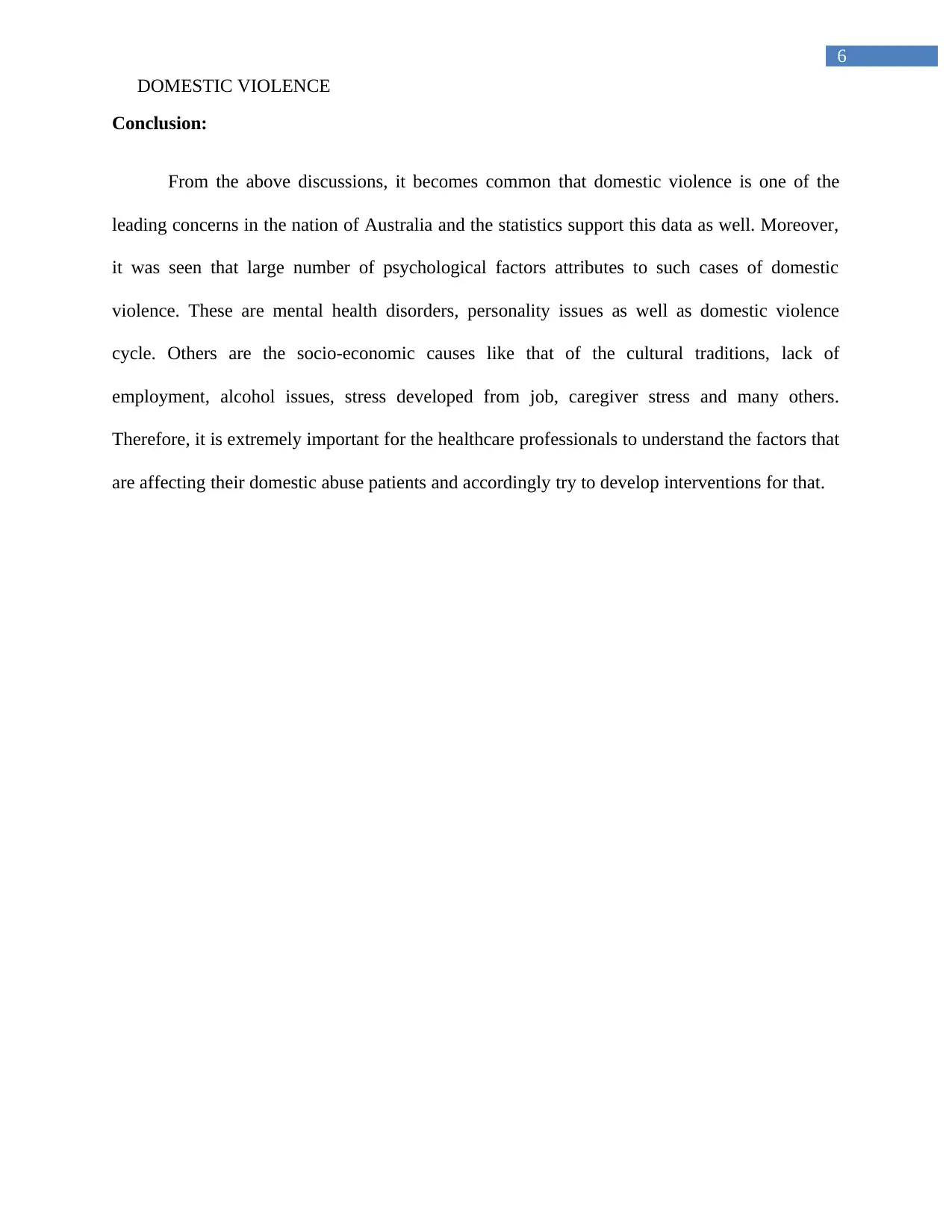
6
DOMESTIC VIOLENCE
Conclusion:
From the above discussions, it becomes common that domestic violence is one of the
leading concerns in the nation of Australia and the statistics support this data as well. Moreover,
it was seen that large number of psychological factors attributes to such cases of domestic
violence. These are mental health disorders, personality issues as well as domestic violence
cycle. Others are the socio-economic causes like that of the cultural traditions, lack of
employment, alcohol issues, stress developed from job, caregiver stress and many others.
Therefore, it is extremely important for the healthcare professionals to understand the factors that
are affecting their domestic abuse patients and accordingly try to develop interventions for that.
DOMESTIC VIOLENCE
Conclusion:
From the above discussions, it becomes common that domestic violence is one of the
leading concerns in the nation of Australia and the statistics support this data as well. Moreover,
it was seen that large number of psychological factors attributes to such cases of domestic
violence. These are mental health disorders, personality issues as well as domestic violence
cycle. Others are the socio-economic causes like that of the cultural traditions, lack of
employment, alcohol issues, stress developed from job, caregiver stress and many others.
Therefore, it is extremely important for the healthcare professionals to understand the factors that
are affecting their domestic abuse patients and accordingly try to develop interventions for that.
Paraphrase This Document
Need a fresh take? Get an instant paraphrase of this document with our AI Paraphraser
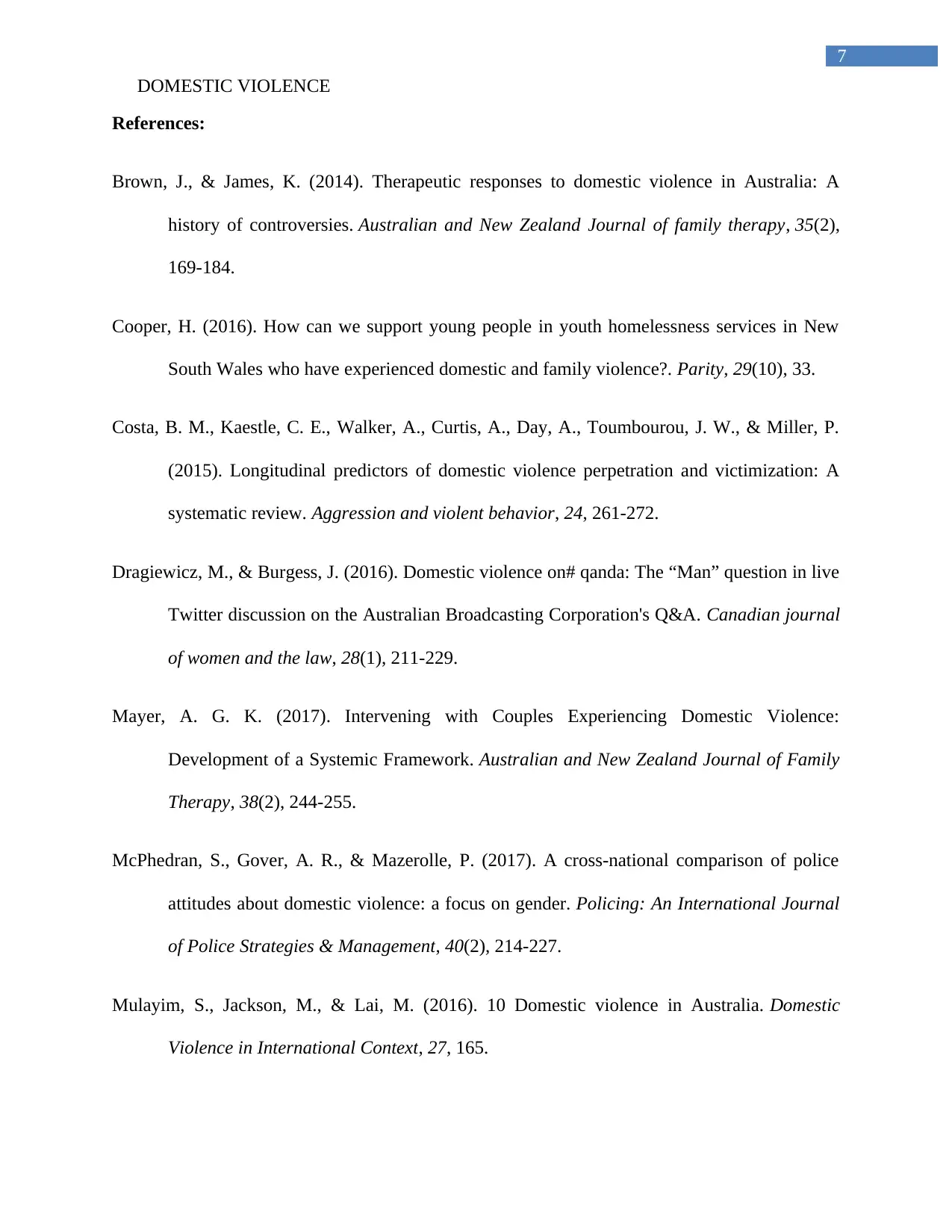
7
DOMESTIC VIOLENCE
References:
Brown, J., & James, K. (2014). Therapeutic responses to domestic violence in Australia: A
history of controversies. Australian and New Zealand Journal of family therapy, 35(2),
169-184.
Cooper, H. (2016). How can we support young people in youth homelessness services in New
South Wales who have experienced domestic and family violence?. Parity, 29(10), 33.
Costa, B. M., Kaestle, C. E., Walker, A., Curtis, A., Day, A., Toumbourou, J. W., & Miller, P.
(2015). Longitudinal predictors of domestic violence perpetration and victimization: A
systematic review. Aggression and violent behavior, 24, 261-272.
Dragiewicz, M., & Burgess, J. (2016). Domestic violence on# qanda: The “Man” question in live
Twitter discussion on the Australian Broadcasting Corporation's Q&A. Canadian journal
of women and the law, 28(1), 211-229.
Mayer, A. G. K. (2017). Intervening with Couples Experiencing Domestic Violence:
Development of a Systemic Framework. Australian and New Zealand Journal of Family
Therapy, 38(2), 244-255.
McPhedran, S., Gover, A. R., & Mazerolle, P. (2017). A cross-national comparison of police
attitudes about domestic violence: a focus on gender. Policing: An International Journal
of Police Strategies & Management, 40(2), 214-227.
Mulayim, S., Jackson, M., & Lai, M. (2016). 10 Domestic violence in Australia. Domestic
Violence in International Context, 27, 165.
DOMESTIC VIOLENCE
References:
Brown, J., & James, K. (2014). Therapeutic responses to domestic violence in Australia: A
history of controversies. Australian and New Zealand Journal of family therapy, 35(2),
169-184.
Cooper, H. (2016). How can we support young people in youth homelessness services in New
South Wales who have experienced domestic and family violence?. Parity, 29(10), 33.
Costa, B. M., Kaestle, C. E., Walker, A., Curtis, A., Day, A., Toumbourou, J. W., & Miller, P.
(2015). Longitudinal predictors of domestic violence perpetration and victimization: A
systematic review. Aggression and violent behavior, 24, 261-272.
Dragiewicz, M., & Burgess, J. (2016). Domestic violence on# qanda: The “Man” question in live
Twitter discussion on the Australian Broadcasting Corporation's Q&A. Canadian journal
of women and the law, 28(1), 211-229.
Mayer, A. G. K. (2017). Intervening with Couples Experiencing Domestic Violence:
Development of a Systemic Framework. Australian and New Zealand Journal of Family
Therapy, 38(2), 244-255.
McPhedran, S., Gover, A. R., & Mazerolle, P. (2017). A cross-national comparison of police
attitudes about domestic violence: a focus on gender. Policing: An International Journal
of Police Strategies & Management, 40(2), 214-227.
Mulayim, S., Jackson, M., & Lai, M. (2016). 10 Domestic violence in Australia. Domestic
Violence in International Context, 27, 165.
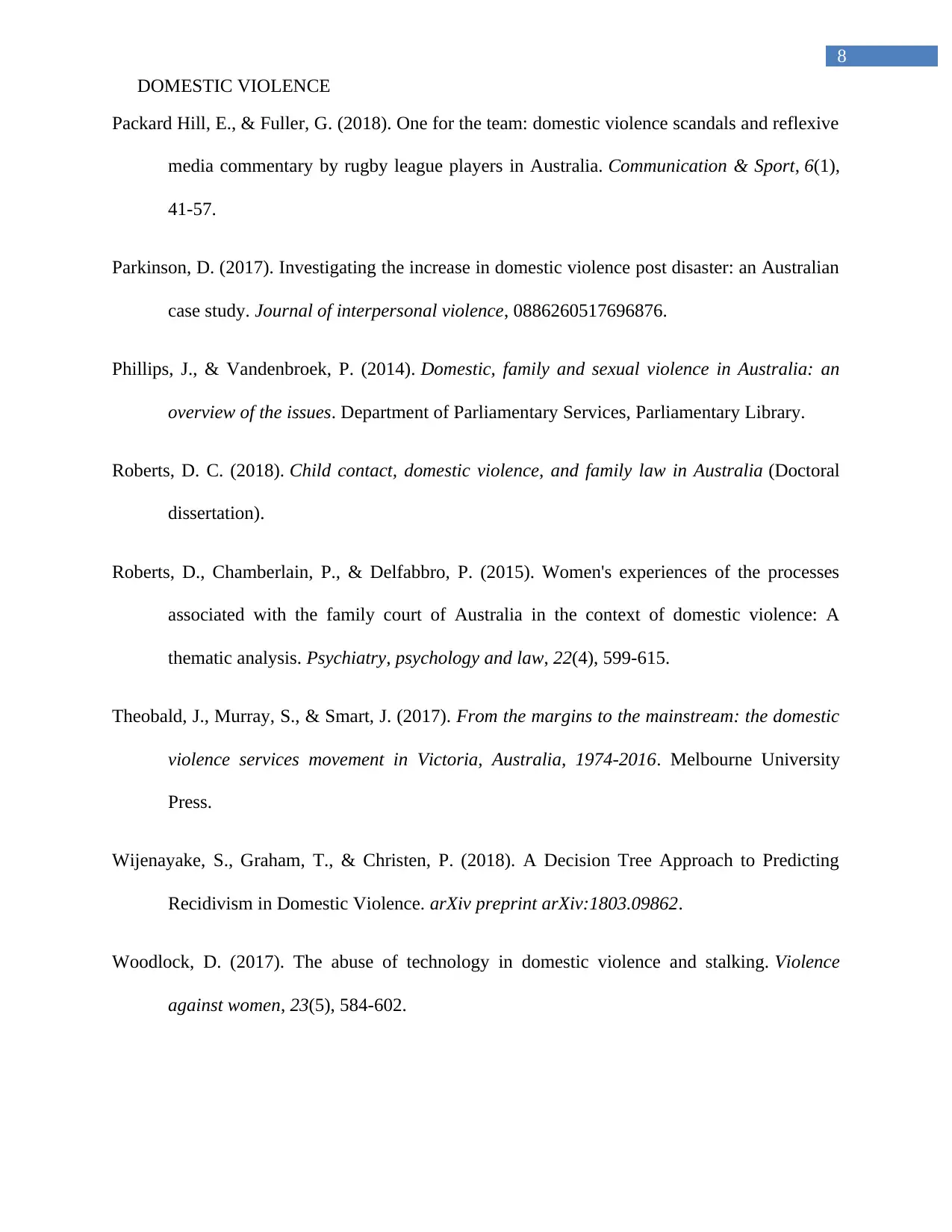
8
DOMESTIC VIOLENCE
Packard Hill, E., & Fuller, G. (2018). One for the team: domestic violence scandals and reflexive
media commentary by rugby league players in Australia. Communication & Sport, 6(1),
41-57.
Parkinson, D. (2017). Investigating the increase in domestic violence post disaster: an Australian
case study. Journal of interpersonal violence, 0886260517696876.
Phillips, J., & Vandenbroek, P. (2014). Domestic, family and sexual violence in Australia: an
overview of the issues. Department of Parliamentary Services, Parliamentary Library.
Roberts, D. C. (2018). Child contact, domestic violence, and family law in Australia (Doctoral
dissertation).
Roberts, D., Chamberlain, P., & Delfabbro, P. (2015). Women's experiences of the processes
associated with the family court of Australia in the context of domestic violence: A
thematic analysis. Psychiatry, psychology and law, 22(4), 599-615.
Theobald, J., Murray, S., & Smart, J. (2017). From the margins to the mainstream: the domestic
violence services movement in Victoria, Australia, 1974-2016. Melbourne University
Press.
Wijenayake, S., Graham, T., & Christen, P. (2018). A Decision Tree Approach to Predicting
Recidivism in Domestic Violence. arXiv preprint arXiv:1803.09862.
Woodlock, D. (2017). The abuse of technology in domestic violence and stalking. Violence
against women, 23(5), 584-602.
DOMESTIC VIOLENCE
Packard Hill, E., & Fuller, G. (2018). One for the team: domestic violence scandals and reflexive
media commentary by rugby league players in Australia. Communication & Sport, 6(1),
41-57.
Parkinson, D. (2017). Investigating the increase in domestic violence post disaster: an Australian
case study. Journal of interpersonal violence, 0886260517696876.
Phillips, J., & Vandenbroek, P. (2014). Domestic, family and sexual violence in Australia: an
overview of the issues. Department of Parliamentary Services, Parliamentary Library.
Roberts, D. C. (2018). Child contact, domestic violence, and family law in Australia (Doctoral
dissertation).
Roberts, D., Chamberlain, P., & Delfabbro, P. (2015). Women's experiences of the processes
associated with the family court of Australia in the context of domestic violence: A
thematic analysis. Psychiatry, psychology and law, 22(4), 599-615.
Theobald, J., Murray, S., & Smart, J. (2017). From the margins to the mainstream: the domestic
violence services movement in Victoria, Australia, 1974-2016. Melbourne University
Press.
Wijenayake, S., Graham, T., & Christen, P. (2018). A Decision Tree Approach to Predicting
Recidivism in Domestic Violence. arXiv preprint arXiv:1803.09862.
Woodlock, D. (2017). The abuse of technology in domestic violence and stalking. Violence
against women, 23(5), 584-602.
⊘ This is a preview!⊘
Do you want full access?
Subscribe today to unlock all pages.

Trusted by 1+ million students worldwide
1 out of 9
Related Documents
Your All-in-One AI-Powered Toolkit for Academic Success.
+13062052269
info@desklib.com
Available 24*7 on WhatsApp / Email
![[object Object]](/_next/static/media/star-bottom.7253800d.svg)
Unlock your academic potential
Copyright © 2020–2025 A2Z Services. All Rights Reserved. Developed and managed by ZUCOL.



